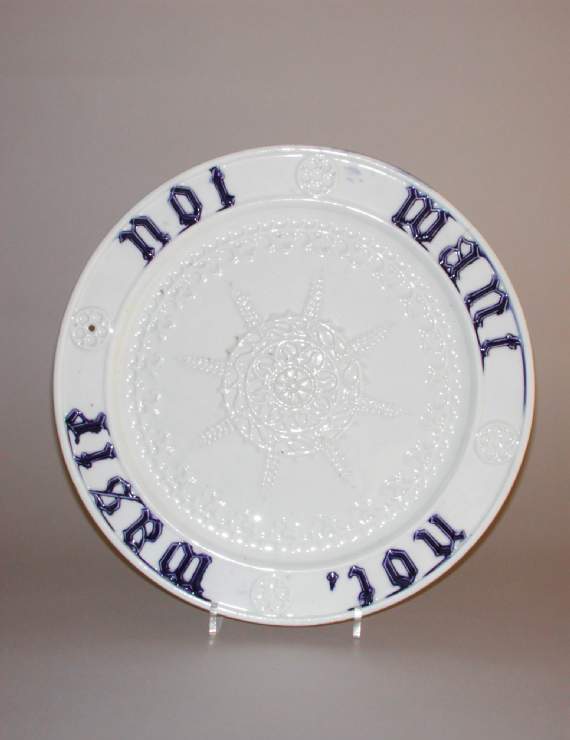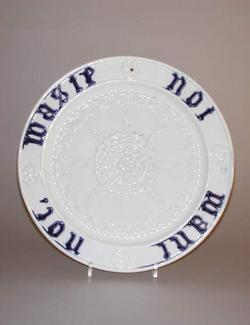Current Location: In storage
Titles
Pugin bread plate
Maker(s)
Production:
Minton & Co.
Mintons Ltd
((from 1873))
Designer:
Pugin, Augustus Welby Northmore
Entities
Categories
Description
Earthenware, moulded in relief, majolica glaze decoration
Circular plate with moulded ridge running around inner and outer sides of rim. Centre decorated with a raised design incorporating eight ears of wheat radiating from a geometric leaf and flower motif , surrounded by a strip of stylised leaves. Rim decorated with the motto ‘WASTE NOT WANT NOT’, in Gothic lettering, the words separated by floral motifs. The letters are glazed deep blue, other parts are clear glazed. The underside is recessed, forming a pronounced foot-rim, and glazed. A suspension hole has been drilled through one of the floral motifs on the rim.
Notes
History note: From the Charles & Lavinia Handley-Read Collection. Purchased from the executor, Thomas Stainton, 1972.
Legal notes
Bought using the Perceval Fund and a Grant-in-Aid from the Victoria and Albert Museum
Measurements and weight
Diameter: 34.3 cm
Height: 2.5 cm
Acquisition and important dates
Method of acquisition: Bought
(1972)
by
Stainton, Thomas
Dating
19th Century, Late
Production date:
AD 1875
: dated
Note
Augustus Welby Northmore Pugin (1812-1852) was a leading proponent of the Gothic style and believed it could be successfully applied to all designs, from domestic tableware to church interiors. A three-coloured, inlaid version of this plate was shown at the Birmingham Exhibition of 1849 and an engraving was printed in the Journal of Design the following year. The design, listed in the Minton ornamental shape books as ‘430 Tray, bread, Pugin’s ‘WASTE NOT WANT NOT’, encaustic (M)’, was available for many years, produced with either inlaid (encaustic) design or in relief-decorated Majolica (the final ‘M’ in the shape book indicates Majolica). On this Majolica example, the factory mark indicates a date after 1873, which is confirmed by the impressed year mark for 1875.
Minton, founded in 1793, originally produced blue printed earthenware and, later, creamware, bone china and other products, particularly tableware. Taking over in 1836, Herbert Minton revolutionised production methods and introduced new lines in encaustic and printed tiles, figures and ornamental wares. Minton encaustic tiles, designed by Pugin c.1850, featured extensively in Pugin’s designs for the interior of the new Palace of Westminster and wares ‘coloured in the Majolica style’ were introduced, to great acclaim, at the Great Exhibition of 1851. In 1858 the business passed to Herbert’s nephew, Colin Minton Campbell (1827-85), who continued the expansion. The early business traded under various names, from 1845 it was known as Minton & Co. and from 1873 as Mintons Ltd.
The ears of wheat in the design symbolise bread, indicating the function of the plate. The motto ‘waste not want not’, first recorded in 1772, would have had special meaning when Pugin designed the plate, at the end of a decade when many people went hungry. An earlier version, ‘willful waste makes woeful want’ was in use from c.1576.
School or Style
Gothic Revival
Components of the work
Decoration
composed of
lead-glaze
Materials used in production
Earthenware
Techniques used in production
Moulding
: Relief moulded earthenware with Majolica glazes
Inscription or legends present
- Text: MINTONS / BB
- Location: Underside
- Method of creation: Impressed
- Type: Factory mark
Inscription present: (script-type letter)
- Text: E
- Location: Underside
- Method of creation: Impressed
- Type: Mark
Inscription present: (Roman type)
- Text: E
- Location: Underside
- Method of creation: Impressed
- Type: Mark
- Text: 430
- Location: Underside
- Method of creation: Impressed
- Type: Mark
Inscription present: tiny oval stamp containing cross
- Location: Underside
- Method of creation: Impressed
- Type: Mark
References and bibliographic entries
Identification numbers
Accession number: C.52-1972
Primary reference Number: 75411
Stable URI
Audit data
Created: Saturday 6 August 2011
Updated: Monday 4 August 2025
Last processed: Monday 4 August 2025
Associated departments & institutions
Owner or interested party:
The Fitzwilliam Museum
Associated department:
Applied Arts





